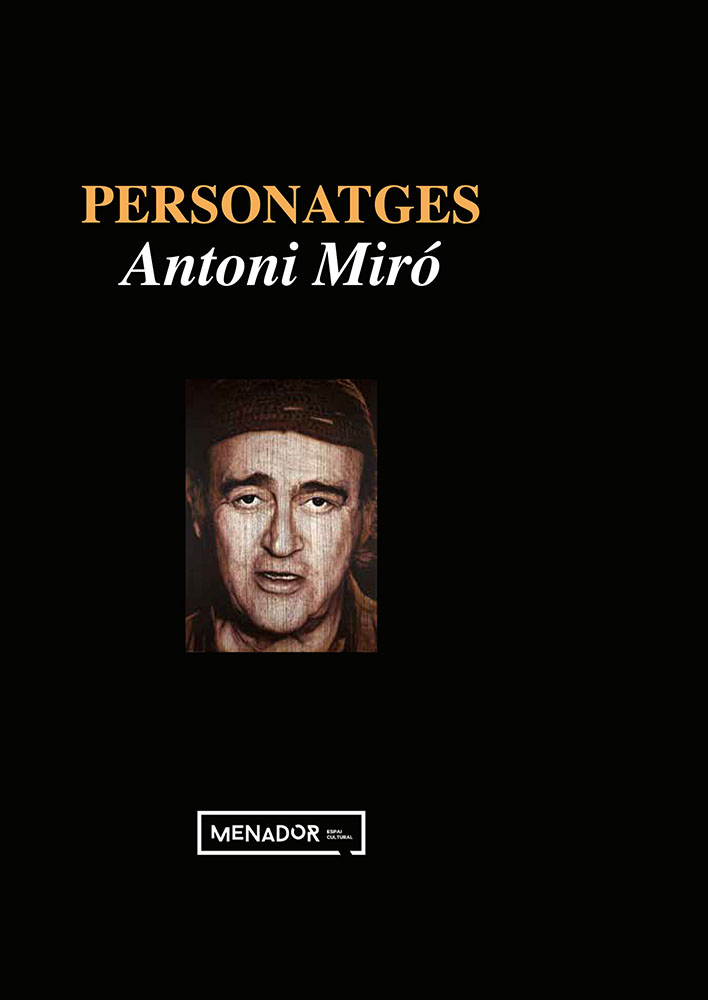Antoni Miró. When art illuminates, fire shines
Feliu Ventura
People say that the world of Antoni Miró is composed by dyes that soak microscopic fibers forming the canvas, by paint that dries slowly and by colors that occupy their space swept by skillful brushes.
They think that it is the passion for the transformation of society with his own work and with the diffusion of the work of others.
People say that Antoni Miró's world is a mysterious, nocturnal world of secrecy and silence.
Some people think that Sopalmo will be the last factory that will close in the “Alcoia” region and that he has maintained for decades an indefinite strike consisting of creating artistic works tirelessly until destroying the owners of the world with the only determining tool to do it: culture.
Toni reminds me the anecdote told by the poet Joan Brossa when he went to renew his ID and was asked for his profession; He said: «Poet». The official corrected him: «”Paleta”, We put "mason"». Antoni Miró is a mason of art and not only because he holds a palette with his thumb every night, but because he arrives at painting with the strength of his work, a diligent, neat and full of dignity metier, with no masters, but at the service of all.
For me the world of Toni is a world of creation, wherever he is there is a space of creation. Personally, I am lucky enough to experience it because Ausiàs, Sofía and Toni intermittently welcome me to Sopalmo as a castaway person. In his home I made a book and some songs and I'm not the only one and certainly not the last one, while Toni paints, in silence, with a fast and precise rhythm at the same time. Anyone who works trying to follow his rhythm will end going over the top like Charlot in Modern Times. Fortunately there is no competition between our sections in factory. We both like the painting and the music because we like the culture and, although we don't go to mass, we enter into the space of the other with a respect of cathedral and media.
His rebellious look is a mirror and, at the same time, his painting always interrogate us, wounded by humanity. An onslaught that we must know how to gather inside of us to create a disobedient heart. When art illuminates, the fire shines: fuck you! This is the culture. It is not the scope of a council, nor a counseling, nor a ministry. It is not the empty leisure of the worker to make exploitation more bearable, nor the "beneficial" patronage of the owners for cleaning their conscience. It is not an intellectual class competition of the elites, nor the reduction to cultural "industries" that reproduces in the art the exploitation systems of the workers. It is even more than its employees, because it is never unidirectional, it is neither public nor private: it is communal.
Culture is sovereign, disobedient and seditious, and proof of this is found in the judicial sentences of rap singers and comic book artists or in the fact of pulling off obscenely with a radial the sculpture "April 25, 1707" by Antoni Miró, in Gandia. As a reminder, friends, culture is not the music imprisoned you hear in a elevator, or a clothing store, nor the decoration of a hotel room, it is not the stuffed trophy on the fireplace, not the urban "donuts" surrounding the roundabouts of the highways. Culture is a vocation of rebellion, insurrection and disobedience.
Celebrities is that, painting that creates awareness through the awareness of the painting itself, and he does it with the representation of women and men who understand culture as one of the "hammers of thought", words of Miquel Duran de Valencia. We find Isabel-Clara Simó as a hammer of feminism in literature; Enric Valor as a hammer of the oral narrative tradition. We have Víctor Jara, Lorca or Miguel Hernández as hammers of historical memory of repressed art, and we listen to Raimon, Bonet, Ovidio, Léo Ferré and Pau Casals as hammers of music and committed songs. We see Dalí and Tàpies as avant-garde hammers; we read Estellés and Espriu as voluptuous hammers of language. And, without moving a millimeter, we find the hammers of Marx, Fuster, Freud. We can also see Salvador Allende, the president who organized "the train of culture" to disseminate it town by town, and the promoter of the greatest literacy campaign of the last century, called Che.
As we face each painting, words, shapes, sounds and colors penetrate us and, at the end of this visit, overcome by this fire of canvas with all the expressive force of texture and sonority, we take the road thinking that there will always be someone missing in this gallery of Celebrities. It is inevitable, but it is part of Miró's work as a deliberately unfinished play that keeps hitting the viewer, the hammer of thought, after contemplation.
Said that, I dare now paint Antoni Miró in my gallery of celebrities: reference, promoter and disseminator of all the arts. Arts, in the plural, but at last : plumbers, shutters and carpenters we are all together at the construction site building culture.
There is a personage, however, who will not be part of this series. It is the "Feli-Felip" upside down in the “Casa de l'Ensenyança” (Museum of Fine Arts) of Xàtiva that the Almudín Museum acquired in 1989. It is not part of Celebrities, but it follows the thread of Antoni Miró's work and I invite you to fit the piece.
One day I read that "the life of one does not fit in one's life, but in the life of many" and this is also the world of Toni: it is what he has done, everything that he has made us do and what he will make us do.
